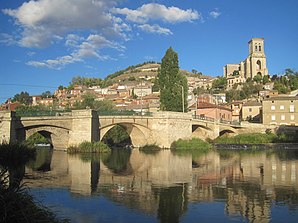Pampliega
| Pampliega municipality | ||
|---|---|---|
 Pampliega - town view with the bridge over the Río Arlanzón and the church of San Pedro
|
||
| coat of arms | Map of Spain | |
 Help on coat of arms |
|
|
| Basic data | ||
| Autonomous Community : | Castile and León | |
| Province : | Burgos | |
| Comarca : | Arlanza | |
| Coordinates | 42 ° 12 ′ N , 3 ° 59 ′ W | |
| Height : | 809 msnm | |
| Area : | 24.4 km² | |
| Residents : | 291 (Jan. 1, 2019) | |
| Population density : | 11.93 inhabitants / km² | |
| Postal code : | 09220 | |
| Municipality number ( INE ): | 09250 | |
| administration | ||
| Website : | Ayuntamiento de Pampliega www.pampliega.es/ Ayuntamiento de Pampliega | |
Pampliega is a municipality ( municipio ) with 291 inhabitants (as of January 1, 2019) in the northern Spanish province of Burgos in the autonomous community of Castile and León .
location
Pampliega is located on the lower reaches of the Río Arlanzón in the west of the province of Burgos at an altitude of about 800 meters above sea level. d. M. The nearest city is the provincial capital of Burgos , about 34 kilometers (driving distance) to the northeast ; The small town of Lerma , located about 32 kilometers to the south-east, is also worth seeing .
Population development
In the 19th century the place had over 1,000 inhabitants at times, now there are only about 350.
economy
In earlier centuries the small town lived from agriculture in its vicinity; at the same time it functioned as a mercantile and craft center for the surrounding communities and hamlets.
history
Pampliega is possibly identical to Ambisma , mentioned by Claudius Ptolemy in the 2nd century AD , which was an important intersection of several Roman roads. The local proclamation of the Visigoth nobleman Chindaswinth as king in 642 is also not completely certain ; the name of the coronation site is documented as Pamplica . In a document written centuries later, this place is also called the place of retreat and death of Wambas (ruled 672-680), whose bones Alfonso X brought to Toledo in the 13th century and had them buried in the local church of Santa Leocadia .
Attractions
- While the medieval castle ( castillo ) has disappeared, some remains of the wall and three unadorned city gates are still preserved from the city fortifications ( murallas ).
- The parish church ( Iglesia San Pedro ), originally from the 13th century, was opened in the 16th and 17th centuries. Almost completely renovated in the 19th century and dominates the townscape with its soaring west tower. The portal integrated into the south transept facade still shows clear late Gothic forms; on the other hand, the west portal in the open tower vestibule is entirely committed to the Renaissance style . The single nave and the two transept arms are uniformly covered by star vaults; which develop from the fan-shaped spreading ribs of the capitalless bundle pillars in front of the wall . The eye-catcher, however, is the imposing multi-part and multi-figure altarpiece by Domingo de Amberes from the mid-16th century in the polygonal broken apse , which is carved entirely from walnut , oak and pine and then colored or gilded. Another attraction is the stone pulpit with the relief busts of the apostles Paul , Peter and Andreas . Further baroque altars complete the interior of the church.
Web links
- Pampliega, church - information (spanish)
Individual evidence
- ↑ Cifras oficiales de población resultantes de la revisión del Padrón municipal a 1 de enero . Population statistics from the Instituto Nacional de Estadística (population update).

